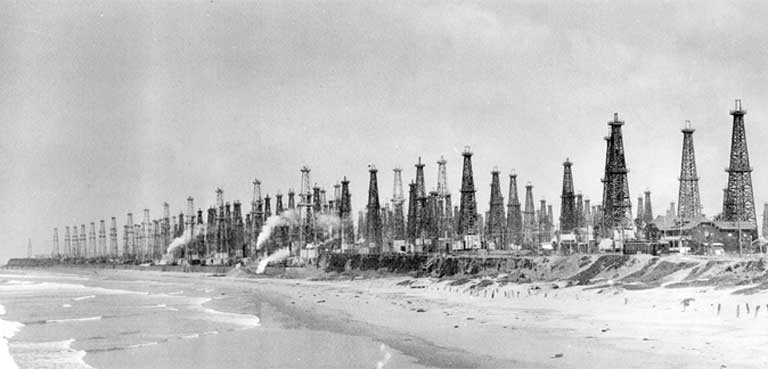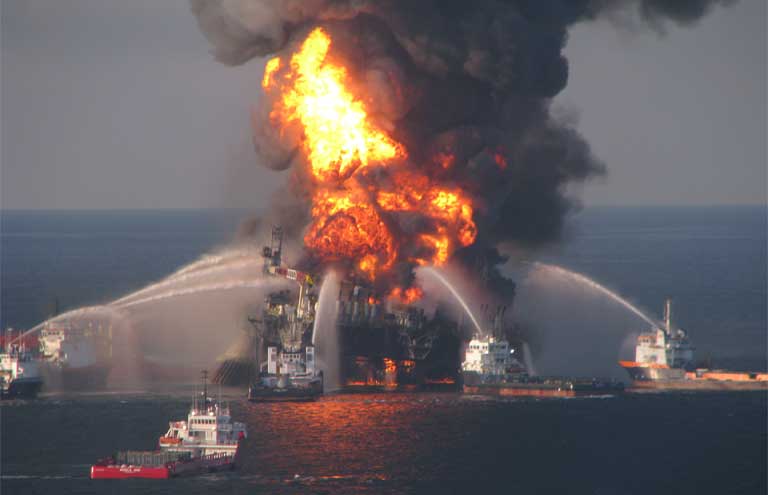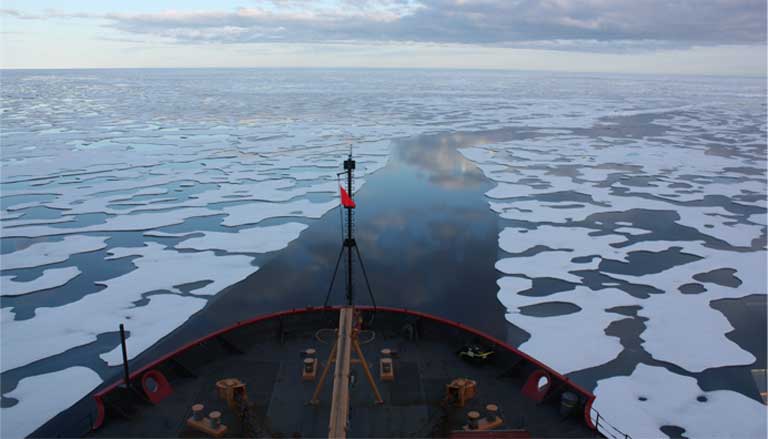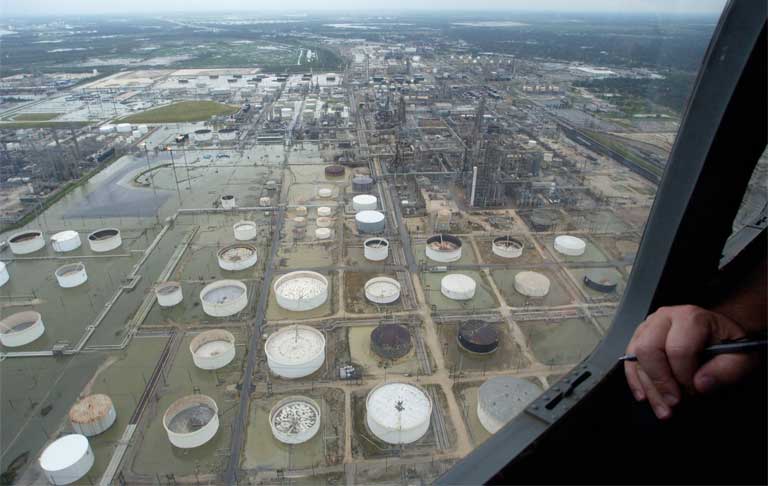- 90 billion barrels of recoverable oil, plus 327 trillion cubic feet of natural gas lie untapped offshore on the U.S. continental shelf. In January, the Trump administration ordered that the entire coast, in the Pacific, Atlantic, Gulf, and Arctic, be opened to drilling.
- Environmentalists and the coastal states fear oil spills that could devastate tourism. They also are concerned about the massive infrastructure (pipelines, terminals, refineries, pumping stations and more) that would be needed to support the industry.
- The executive branch has moved forward with efficiency to create a surge in U.S. oil and gas production: the Interior and Energy departments, and the Environmental Protection Agency have all worked to slash regulations and open additional lands and seas to oil and gas exploration, with the plan of achieving U.S. “energy dominance” around the globe.
- Most coastal states are resisting the federal oil and gas offshore drilling plan; Florida has already been exempted, while other states are likely to fight back with lawsuits. The irony is that a flood of new U.S. oil could glut the market and drive prices down, resulting in an economic disaster for the industry.

For generations the U.S. oil and gas industry has dreamed of the forbidden deep. For hundreds of miles along all four American coasts – the Atlantic, Gulf, Arctic, and Pacific – the continental shelf slopes gradually downward until it falls away abruptly, into the abyssal depths. Beneath that shelf’s sediments lie riches.
According to estimates by the Interior Department’s Bureau of Ocean Management there are 90 billion barrels of undiscovered technically recoverable oil plus 327 trillion cubic feet (TCF) of natural gas down there – a potential fortune in petro profits, and a climatologist’s worst nightmare.
But for generations, that oil and gas has been off limits. Drilling has been banned off the Atlantic Coast since the early 1980s, and off the west coast of Florida since 1988. It is also banned off the Pacific Coast, where the 1969 Santa Barbara spill helped start the environmental movement. That leaves only part of the Gulf – off Texas, Louisiana, Mississippi, and Alabama – open to drilling.
However, the restrictions on American offshore oil and gas production has always been precarious; the executive branch has complete authority to decide what happens in the federal waters of the outer continental shelf, from 3 to 200 miles out to sea.

Then came Trump
President Obama briefly considered reopening the southeast Atlantic Coast to drilling in 2010, but local outcry and the catastrophic Deepwater Horizon spill quashed that plan.
The Trump Administration is thinking bigger: much bigger. As part of its goal for achieving “energy dominance,” it is moving full-steam ahead to open up the entire U.S. coastline to drilling. In January, Interior Secretary Ryan Zinke submitted his new federal lease 5-year plan, which would open up the Atlantic, Pacific, and Arctic coasts to drilling.
Where Obama restricted drilling to about 6 percent of U.S. waters, Zinke would open it to more than 90 percent.
And while the details of the new leasing plan are being developed, the administration is moving fast to sell already sanctioned offshore resources: on Wednesday, March 21, the Interior Department will host what it is marketing as the largest ever federal lease sale in American history, an all-you-can-buy event in which 77 million acres of the Gulf Coast – an offshore area the size of New Mexico – will be up for sale to oil and gas companies wanting to drill.
As chaotic as the Trump administration has been on some issues, the Executive branch has moved forward with efficiency to create a surge in U.S. oil and gas production: Interior Department Secretary Ryan Zinke, Environmental Protection Agency (EPA) Administrator Scott Pruitt, and Energy Department Secretary Rick Perry have all worked in unison to slash regulations and open additional lands and seas to unleash a flood of oil and gas exploration and production in the hopes of achieving U.S. “energy dominance” around the globe.
The phrase, “energy dominance,” seems to have originated in a speech made by candidate Trump in North Dakota – an epicenter for U.S. oil and gas hydraulic fracking, and the site of the Standing Rock anti-pipeline camps. Though the so-called oil shale revolution has produced so much U.S. crude that Obama ended the country’s forty-plus year ban on oil exports, Trump wants more. “American energy dominance,” he told the crowd in Bismarck, “will be declared a strategic, economic and foreign policy goal of the United States. It’s about time!”

In a Washington Times op-ed pegged to Trump’s June 2017 “Energy Week” observance, cabinet members Zinke, Pruitt and Perry defined the concept further: “An energy-dominant America means a self-reliant and secure nation, free from the geopolitical turmoil of other nations that seek to use energy as an economic weapon… an energy-dominant America will export to markets around the world, increasing our global leadership and influence.”
Back in March 2017, Trump signed an executive order reviewing “All Agency Actions that Potentially Burden the Safe, Efficient Development of Domestic Energy Resources.” Under this authority, Zinke, Pruitt and Perry launched a dizzying array of rollbacks to Obama era environmental policies, slashed regulations and opened federal lands and waters to drilling.
In the deregulation category, EPA sought to kill a rule requiring oil and gas companies to report methane emissions; also on the chopping block were rules to limit CO2 from new or modified power plants (a component of the Obama Clean Power Plan); rules to regulate coal ash; and a rule that applies Clean Water Act protections to small streams.
The Interior Department moved fast to make federal lands and waters more attractive to industry. It cut royalties on new offshore rigs by a third, to their lowest allowable rate; it reopened federal land to new coal leases, and then, in coordination with the coal industry, worked to reopen a tax loophole that Obama had closed for valuing coal mined on federal lands. It also opened more federal land to drilling – recommending that the administration shrink the Bears Ears and Staircase Escalante National Monuments, and holding lease auctions on vast swaths of Western lands.

Offshore lease sale
Still, the biggest shift came on the coasts. The Trump Interior Department revised the Obama-era five year offshore drilling plan meant to guide policy from 2017-2022, and will now allow new drilling in the Gulf, which Obama had largely restricted after the BP Deepwater Horizon accident.
The first Trump offshore lease auction, in August 2017 raised $121 million. Meanwhile, the administration continues extolling next week’s 77 million acre New Orleans offshore lease auction in Trumpian marketing terms: as the biggest ever.
However, Athan Manuel, director of the Sierra Club’s Lands Protection Program, downplays the March sale’s significance. He told the Washington Post back in October that the sale wasn’t really news – just what Obama had proposed, plus a few percent.
The gulf, Manuel explained, has long been “a sacrifice zone for the oil and gas industry.” Virtually all of America’s offshore oil and gas rigs (providing about 17 percent of U.S. production) are along the Gulf Coast, as is almost half of the country’s refinery capacity; a fact that the country was unhappily reminded of when it was all shut down during Hurricane Harvey in 2017. Fully three-quarters of America’s fuel is refined on the Gulf Coast, and susceptible to climate change intensified storms and sea level rise – an issue unaddressed by the current Interior Department plan.

Drilling every coastal state
In January 2018, Interior’s Zinke went much further: for Trump’s 2019-2024 energy plan, he proposed opening drilling on the entire outer continental shelf, on all four coasts.
“By proposing to open up nearly the entire OCS [Outer Continental Shelf] for potential oil and gas exploration, the United States can advance the goal of moving from aspiring for energy independence to attaining energy dominance,” explained Vincent DeVito, the Interior Department’s Counselor for Energy Policy.
Almost all coastal state governors, whether Republican or Democrat, responded with staunch opposition. Some like Republican Governor Larry Horgan of Maryland, threatened legal action, with good reason. Most of the economies and tax bases of these shore states rely on tourism, along with commercial and recreational fishing. Florida brings in about $50 billion annually from tourists; the Jersey Shore earns nearly $44 billion. A March 7 study by Oceana International found that 2.6 million jobs and nearly $180 billion in GDP in coastal states are “ocean-dependent.”
The governors logically fear the potential impacts of a BP Deepwater Horizon–style spill, which gutted the Gulf tourism industry, a business which rivals the offshore oil industry in revenue. The states are also concerned over the dirty development oil and gas drilling and refining would bring onshore.
“In order to accommodate offshore drilling, a whole host of infrastructure is required to pump, move and process that oil,” explained Diane Hoskins, the anti-offshore drilling campaign director at Oceana. “And that’s not something coastal communities want – [they] don’t want to turn beach towns into oil towns.” Since Zinke’s announcement, she reports, 200 coastal municipalities have passed resolutions against offshore drilling.
Another fear, specific to the Atlantic and Gulf coasts, is the ever more powerful hurricanes, super-rain events, and storm surges brought by a warming world. During Hurricane Harvey, the unprecedented rains – with multi-day downpours totaling 5 feet in some areas – submerged tank farms and Superfund sites, causing 22,000 barrels of oil and refined chemicals to leak, as well as 365 tons of toxic gas releases, including toxic benzene. Rising sea levels also put coastal oil and gas infrastructure increasingly at risk.
A spill in the Arctic could be even worse. Rear Admiral Jonathan White, former Navy chief oceanographer, and head of its climate change task force, told Scientific American: “The East Coast, West Coast, anywhere in the world except the Arctic, you can get [cleanup] booms, you can get platforms, you can get people and material there,” he said. “In the Arctic, it’s almost like trying to get it to the moon in some cases.” White noted that there is no known or approved procedure for getting oil off ice.
The Trump administration seems willing to take these environmental risks for what amounts to very little energy dominance: Oceana estimates the oil reserves off the Atlantic, Pacific, and Florida Gulf coasts are only enough to last the country 2 years; the natural gas offshore reserve would be gone in just a year.

A half-cooked energy plan?
The Trump administration has a problem: while the federal government wields unchallenged authority in federal waters, it will still need the full backing of coastal state governments for its leasing plans: oil drillers will need to get state infrastructure permits to build oil and gas terminals, pipelines, pumping stations and refineries to support offshore drilling.
In recognition of that reality, Secretary Zinke said he was willing to negotiate the opening of 94 percent of U.S. waters to drilling: “The states, local communities, and congressional delegations will all have a say,” he stated. After Florida Republican Governor Rick Scott tweeted that he and Zinke were going to have to meet, its coast was exempted from the coming statewide lease sale.
For everyone else, the public comment period for the 2019-2024 plan closed on March 9. Those federal comment sessions, Oceana’s Hoskins noted, tended to be held inland, far from affected coastal communities. While Zinke has promised to listen to all stakeholders, he is sticking to the Trump fossil fuel talking points: “We want to grow our nation’s offshore energy industry, instead of slowly surrendering it to foreign shores.”
What many analysts find perplexing about Trump’s “energy dominance” policy is that while it appears to benefit big oil and gas, it could well threaten the industry. That’s because the industry’s most recent crisis came not from lack of drilling, but from over production. A January article in Forbes titled “Trump’s American Energy Dominance Agenda Becoming Reality” unintentionally highlighted this paradox, opening with a note that the outlook for American oil is strong, precisely because “the U.S. rig count remains remarkably stable.” That is, because the country’s producers aren’t exploring for more oil or drilling new wells.
Here’s what precipitated the recent crisis: Starting in mid 2014, the country’s thousands of independent oil and gas producers, hoping to take advantage of oil prices above $100 per barrel, began aggressively fracking the West, releasing a flood of domestic American oil. That drilling frenzy – combined with the Saudis’ decision to open their taps – created an oil glut that brought world oil prices down to an early-2016 nadir of $26 a barrel, far below the price that could justify renewed exploration and development, particularly in the expensive and hazardous offshore domain.
It took a year for oil prices to rally back to $50 a barrel. And then oil and gas companies once again crashed prices in what Forbes called a “self-destructive rush to increase drilling.” It took a combined multilateral deal between Russia and OPEC, and a lot of meetings in American energy company boardrooms, to limit supply.
The industry calls this need for careful control, “capital discipline,” a business strategy of restricting supply sufficiently to push prices into the $60-70 range, where they are today. But the Trump administration’s energy policy threatens to rapidly ramp up production on-land and offshore, shattering all attempts at capital discipline, putting the industry economically at risk.

Will big oil and gas buy in?
According to Lorne Stockman of Oil Change International, a think-tank focused on the post-carbon economy, it isn’t clear how popular the new offshore leases will be with fossil fuel companies, particularly outside those areas of the Gulf already crowded with rigs and infrastructure.
Developing new offshore areas, as Zinke’s plan proposes, will require a huge investment by the firms to establish new offshore and onshore infrastructure – new drilling platforms, underwater and underground pipelines, terminals, and refineries would all need to be built.
The Gulf already has this infrastructure, and even with that, according to a recent Oil Change International (OCI) study, profits are slim; 76 percent of new Gulf offshore leases, and 45 percent nationwide, are only breaking even, and that’s with the help of federal subsidies. “If you’re in the already crowded parts of the Gulf,” Stockman explains, “the break-even price could be $50 to $70 a barrel; if you’re breaking into completely new areas, it’ll be $70, $80, upwards.”
On the Arctic frontier, the costs are even more prohibitive: the last serious attempt to drill offshore in the Arctic was when Royal Dutch Shell tried to drill in the remote Beaufort Sea in 2015, which ended with the company spending $7 billion on a dry hole. On land, fracking is barely a break-even enterprise: 60 percent of the oil in the Bakken shale, in North Dakota, is subsidy dependent, according to OCI.
Stockman questions the economic prudence of any company undertaking offshore development in states where no production is presently occurring: “Drilling an [onshore] shale well takes $20 million. Flip a switch and drill it tomorrow, or hold till next month when prices are better,” he said. However, “An investment offshore is a multibillion multi-year enterprise.“

Investment in energy dominance, or a political scam?
Given these financials, it seems logical to ask why the industry wants a massive offshore expansion. “Well, that’s the question,” Stockman laughs. “Is it even something they do want?”
The push to open all U.S. waters to drilling, he explains, has been an industry dream for decades, but as such, it is also a relic of the wildcatting past – a desire that recurs from time-to-time, as it did in the 1970s and early 2000s, when it was believed American oil and gas were in long term decline, with its only way forward the production of ever more remote and expensive fields.
The boom in shale gas and oil flipped this paradigm on its head, as has the little publicized, but real, slow downtick in demand for oil, with greater declines forecast if advances in electric and automated vehicles come to fruition. (Vehicles currently account for about 60 percent of oil consumption.)
The oil industry and finance press has already begun to speculate that the world may be past, or fast approaching “peak oil demand.” And looming over all this economic talk – as markets and insurers are beginning to realize – is the fact that the world’s store of technically recoverable oil and gas resources cannot be burned without catastrophically destabilizing the planet’s climate.
With all that in mind, the industry has shown little inclination to develop new fields – exploration is at a 70 year low. “I’m not saying expanded offshore development isn’t potentially gonna happen one day,” Stockman says, “but in a typical Trump administration move, they’ve ruled on the industry’s agenda without much insight of whether it’s something of particular importance at this moment.”

So it is, that America awaits the results of the biggest federal oil and gas lease sale ever. But whatever bids are made next Wednesday, and in upcoming lease sales, that doesn’t mean we’ll see drilling tomorrow. Purchased leases need to be seen for what they are: long term planning. Leases approved in 2017, for example, won’t start making money until 2027 at the earliest, and there is no telling what the world energy landscape will look like then.
Still, Stockman adds, the expansion into America’s oceans makes sense in terms of speculation. It’s a way for oil and gas companies to lock down acreage they may or may not ever develop, just in case oil prices spike again. And, as New York financiers investing in barely solvent fracking companies have learned to their displeasure, drilling is, for the companies, to some extent an end in itself.
“The industry is eternally optimistic about its future,” Stockman concludes. “They completely dismiss the prospect of climate policy becoming a challenge, and they completely dismiss hard economic data that more efficient vehicles and EVs will take their market share away. So it’s completely in their framework to say, ‘Sure, we want to start expanding into new areas that might require $100 [per barrel] oil in the mid-2020s, because that’s how we see the future.’ And given the current administration you can’t blame them.”
FEEDBACK: Use this form to send a message to the author of this post. If you want to post a public comment, you can do that at the bottom of the page.
